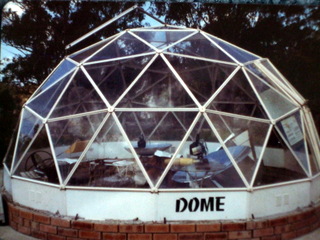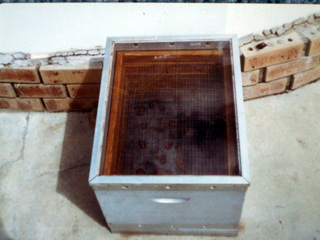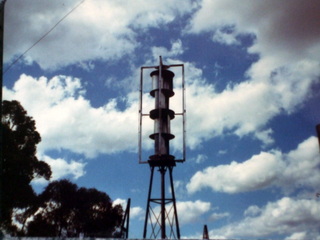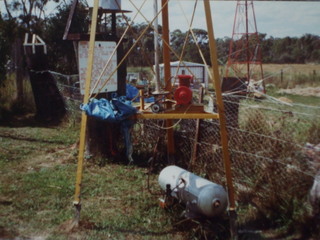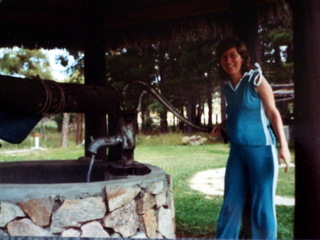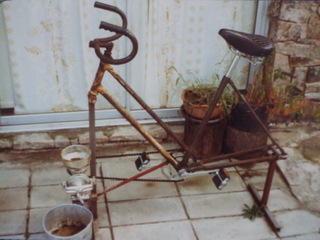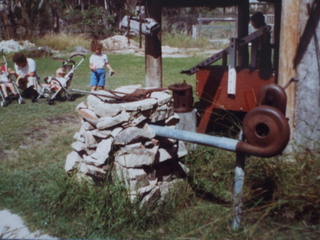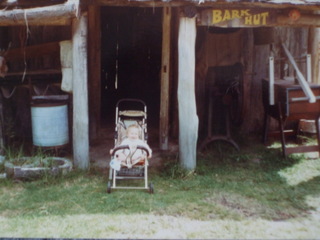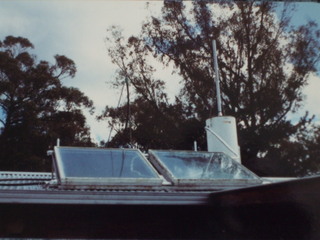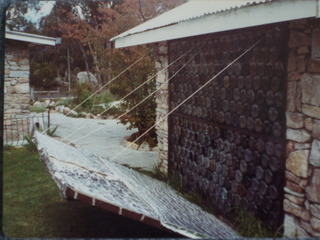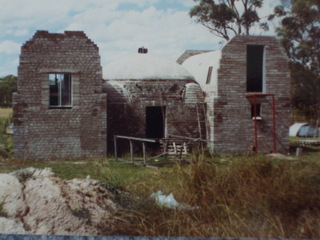Back in the early ‘80s (March 1983 to be precise) my somewhat pregnant wife, daughter and Iwere visiting relatives up in the Stanthorpe area of southern Queensland, and they told us about a place that they thought might be worth a visit – The sun Powered Eukey Complex. This was (I suspect it no longer exists, at least in the form it did then) a series of buildings and structures built to demonstrate design principles for using renewable energy both directly and indirectly. It was located near Stanthorpe at Eukey, on Storm King Dam Rd which no doubt contributed to the name. The place obviously made an impact on me otherwise I would not be writing about it damn near 30 years later. However, recent events caused me to see if there was anything about it elsewhere on the net and after some research turned up almost nothing so I decided to record our impressions of the place.
Please bear in mind that because it was thirty years ago, my memory of it was not what it was, I did take some happy snaps fortunately but this was well before digital photography so there were not as many as I would have liked and all are reproduced below. I have also scanned and uploaded the brochure we were given on the day here, in two parts so that will fill in some of the stuff that I have forgotten.
The Dome
This was a small geodesic dome which at that stage was a construction method that I hadn’t seen in the flesh before, inside were some solar apparatus used to demonstrate various solar principles. In the photo you can see a couple of parabolic solar cookers and the sundial as well as a solar box cooker similar to ours over the back. What you can’t see are the solar fan, solar water distiller, music box powered by a solar cell, Fresnel lens and flat plate absorber style solar water heaters. There was also a little toy called a radiometer that you used to be able to buy, but I admit haven’t seen one in many years. They looked like a large light bulb with a fan type arrangement in the centre on a spike and when you place it in the sun, the fan-like thing rotates. It really does not accomplish anything but it is fun to watch!
Solar Food Drier
Outside the dome was a solar food drier based around a bee hive super with some mesh mounted on wooden frames stacked one on top of the other inside and a sheet of glass over the top. I have no idea how well it worked.
Savonius Wind rotor
This was a fairly big unit designed for low speed high torque applications based on four 200 litre drums cut in half lengthways and then mounted one above the other so they caught the wind causing them to turn and rotate a central shaft transferring the power of the wind to whatever you wanted. On the day we were it was pretty still so we did not get to see it in action, unfortunately.
The Compressor
Due to that way the savonius rotor operates it is not ideal for generating electricity unless you gear the thing up pretty heavily, losing power in the process but it can be used to run things like pumps. One innovation that they had here at the complex that did make a big impression on me was to use the output of the savonius rotor to turn an air compressor and pump air into an air receiver so that the compressed air could then be used as a power source at some later time. Again, I have no idea how ell this worked but is seems to me to be a huge idea. It would not work well in an urban or suburban setting due to noise, turbulent caused by buildings and neighbours complaining about it being a eyesore but if you had the space and the skills this would be a great thing to put together.
For years after seeing this I had fantasies about my own savonius rotor but for reasons stated above I had to wave them sadly goodbye.
The Water Pumps
They had an old style well, which they called the “Wishing Well” that was fitted with a cast iron pump which my lovely (and somewhat pregnant) partner in the sustainable life can be seen operating as well as the more traditional windlass and bucket visible in the background to the left.
Pedal Powered Grain Grinder
This is one of the things I saw that I still have a mind to make some day. As you can see in the photo it is an old recycled bicycle frame, attached to a couple of supports to keep it upright and the chain connected to a grain grinder. Our stone grain mill is a great work out and you will be sweating after grinding just a cup or two of wheat by arm power, but this set up would allow you to grind for longer with much less sweat. The only concern would be gearing or moderating your pedalling so it doesn’t go too fast and overheat the flour and stones.
The Forge
Here they have taken stones from the property and built it up to form the tuyere of the forge and connected up an old hand blower. The stones have been contented together and there is some wire mesh on the top to hold the fuel, which I assume would be charcoal which could also be made on the property.
The Slab Hut with Bark Roof
Building dwellings from slabs of timber sourced locally was once a major construction method in Australia and in places where the timber was available; this was a very sustainable and sensible way to build. On the left hand side of the photo in the background is a drum like thing called a copper that was used to boil up clothes before modern washing machines were around, we had a gas one in the house I lived in from age 9 until when we got married. On the right hand side of the photo is a wooden contraption that is a hand powered washing machine, it operated by pumping the handle up and down to move pistons that agitate the clothes in the water-filled body of the machine. The thing in the centre background is either a hand chaff cutter or, more likely, a hand turned mangle used to squeeze excess water out of freshly washed clothes.
Solar hot Water Flat Panels
These set-ups are so common now as to hardly rate a mention but at the time they were a relatively new thing.
The Tromb Wall
This is a north facing wall of a dwelling built of water filled containers, in this case glass bottles, that absorb solar energy during the day, than at night the reflective, insulated wall is hauled back upright again to keep the heat in, which is then released into the room over time to reduce the need for heating. This area may be Queensland but it is still quite high up and the winter nights can result in some pretty hard frosts so this innovation would be welcome. It was popularised, if not invented, by Steve Baer of Zomeworks in the 1980's.
The Mud Brick House
This was obviously still under construction at the time of our visit and I don’t know if it was ever finished.



